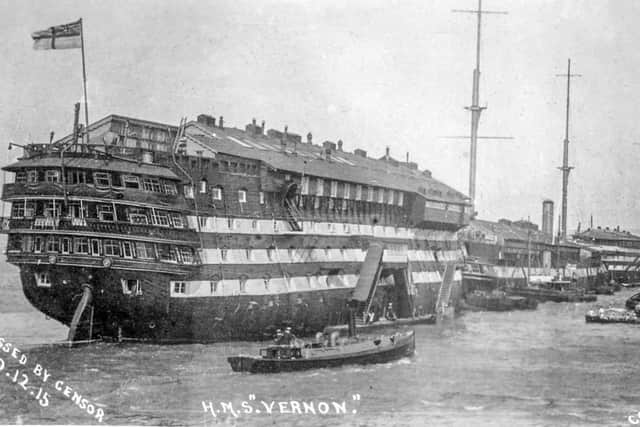Portsmouth torpedo school was launchpad for Royal Navy sailors | Nostalgia


He wrote the article for a postcard magazine which has, unfortunately, gone out of production.
Robert asked if I would like to reproduce it on these pages.
Advertisement
Hide AdAdvertisement
Hide AdI am sure there are many ex-HMS Vernon men who would be interested.
In the latter part of the 19th and the early part of the 20th century within Portsmouth Harbour, the Royal Navy used hulks as floating workshops and accommodation under the name of HMS Vernon.
It took its name from the HMS Vernon launched in 1832 and converted to a hulk at Portsmouth Dockyard.
In 1872 it became a torpedo and mining school attached to HMS Excellent, the floating gunnery school, also moored within the harbour at Fountain Lake.
Advertisement
Hide AdAdvertisement
Hide AdIn 1871 the Royal Navy acquired a licence to manufacture the world-renowned Whitehead torpedo which was way ahead of its time having a gyroscope gear to enable it to keep on course and specific depth to its target.
This torpedo was perfected in 1866 by Robert Whitehead. Also being tested at Vernon was the Brennan torpedo which was used for coast defence work and designed by Louise Brennan, being fired from the shore and guided to its target by wires attached either side.
The Whitehead propelled itself and once launched it could not be controlled in any way.
Independent command status was given to Vernon on April 26, 1876, under the command of Captain W Arthur.
Advertisement
Hide AdAdvertisement
Hide AdHMS Ariadne was attached to Vernon as an accommodation ship. Another ship, the Florence Nightingale, acted as a running stage for torpedoes.
Over the next few years other ships were brought in to perform various duties and to replace the three ships mentioned above as they were taken out of service.
In 1884 HMS Vesuvius joined as a tender and remained in reserve until 1923, then HMS Actaeon joined, followed in 1886 by HMS Donegal which took on the name of Vernon and Torpedo Training Ship. Actaeon was scrapped and the original Vernon renamed Actaeon.
In 1895 all of the hulks making up Vernon were moved to Portchester Creek. HMS Marlborough replaced Ariadne and took the name Vernon II and Donegal Vernon I.
In 1904 Warrior was added as Vernon III.
Advertisement
Hide AdAdvertisement
Hide AdBoth officers and men lived on board Ariadne and over the course of a year some 1,300 men passed through the Torpedo School.
Most were able seamen who had to gain a certain standard in the Gunnery School at HMS Excellent to be able to attend the Torpedo School at Vernon for four months training.
Each seaman had the rank of SG (Seaman Gunner) and if he passed out of the Torpedo School a ‘T’ is added to represent torpedo with a corresponding increase in pay.
An ambitious man could reach the rank of LTO or Leading Torpedo. Each man had to return to Vernon every three years for further instruction owing to the rapid advances in torpedo technology.
Advertisement
Hide AdAdvertisement
Hide AdBesides Vernon, torpedoes were tested at a purpose-built lake in the northern part of the harbour at Horsea Island.
Originally this was two small islands, Great and Little Horsea, and used by the gunpowder magazine at nearby Tipner.
In 1889 the two islands were joined using convict labour and chalk from Portsdown Hill.
In 1905 the length of the lake was increased from 730 metres to more than 1,000 metres but, by the First World War, it became obsolete owing to the rapid advances in torpedo technology.
Advertisement
Hide AdAdvertisement
Hide AdIt was in 1923 that Vernon went ashore at the old Gunwharf site.
It stayed there until 1986 when they vacated Gunwharf and the establishment was split up into smaller units and moved to other establishments.
The site has been converted into the Gunwharf Quays shopping complex.
In his marvellous book The Portsmouth Letters, the late Admiral Sir William James, Commander in Chief, Portsmouth 1939-1942 and a personal hero of mine, tells of events that occurred in his time as the top naval man in Portsmouth through the early years of the Second World War.
James Road at Bedhampton is named after him.
Advertisement
Hide AdAdvertisement
Hide AdJames had a great admiration for Winston Churchill and, of his speeches, he called the man ‘a spellbinder’.
In one speech when visiting Portsmouth, Churchill used the phrase ‘We have only to persevere to conquer’. With all that is going on in the country, I think that phrase counts as much today as it did then.